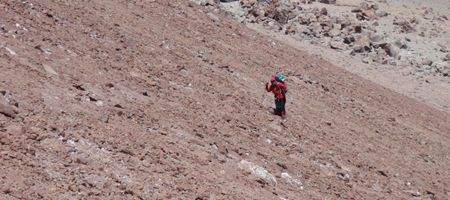Scientists have discovered new types of organism living in one of the most inhospitable soils in the world – raising hopes that something similar could survive on Mars.

The University of Colorado Boulder team carried out a DNA analysis of rocky soils on volcanoes in South America – one of the most Mars-like environments on Earth.
And, remarkably, they’ve found bacteria, fungi and other rudimentary organisms called archaea, which actually seem to have a new way of converting energy.
“We haven’t formally identified or characterized the species,” says Ryan Lynch, a CU-Boulder doctoral student involved in the study.
“But these are very different than anything else that has been cultured. Genetically, they’re at least five percent different than anything else in the DNA database of 2.5 million sequences.”
Conditions on the slopes of the tallest volcanoes in the Atacama region are about as inhospitable as it gets. When snow does fall, it generally sublimates back to the atmosphere very quickly, and the soil is so short of nutrients that nitrogen levels in the scientists’ samples were too low to detect.
Ultraviolet radiation in the high-altitude environment is intense, and temperatures can drop to 14 degrees Fahrenheit one night and spike to 133 F the next day.
How the newfound organisms survive under such circumstances remains a mystery. Although the team looked for chlorophyll and genes known to be involved in photosynthesis, they couldn’t find evidence that the microbes were photosynthetic.
Instead, they think they might slowly generate energy from chemical reactions, extracting energy and carbon from wisps of gases such as carbon monoxide and dimethylsulfide that blow into the area.
This wouldn’t give much of a yield, but could just about be enough for survival.
Whatever they’re doing to survive, they’re an indication that life could be possible even on Mars, and the scientists are now working with astrobiologists to evaluate the possibilities. With their rocky terrain, thin atmosphere and high radiation, after all, the Atacama volcanoes are some of the most similar places on Earth to the Red Planet.
“If we know, on Earth, what the outer limits for life were, and they know what the paleoclimates on Mars were like, we may have a better idea of what could have lived there,” says professor Steve Schmidt.






